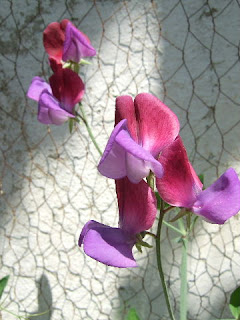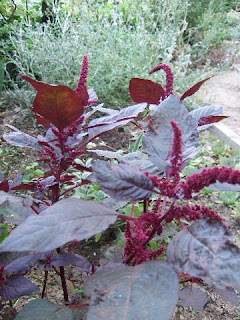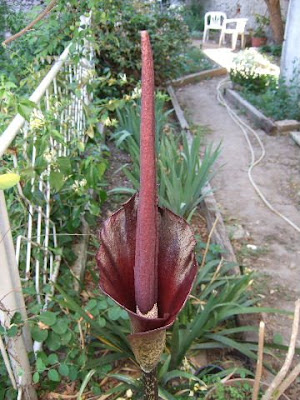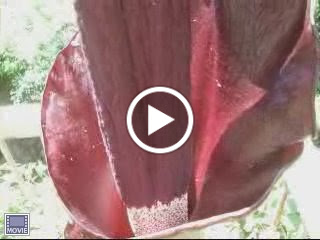
I'm not much of an early morning person... Actually I love early morning but early morning doesn't like me. But today I did decide to rise with the chickens (well, somwehere) and get out into the garden to photograph - and then collect - one of the treats of summer: squash blossoms. I set the clock for 8:30 but for some godly unknown reason woke up at 7, and coffee in hand, stumbled out into the garden. There was no sound except birds, a dog barking somewhere and the rumble of distant thunder. As soon as I finished shooting, the first drops began to fall.
Ben hiç bir anlamla erkenci değilim. Aslında erken sabah vaktini çok seviyorum fakat o beni sevmiyor galiba... Yine de bugün yazın sunduğu güzelliklerinden bir tanesini fotoğraflayıp toplamık için tavuklarla (nerede olursa olsunlar) kalkıp bahçeye çıkmaya karar verdim. Çalar saatimi 8.30'a ayarladım fakat nedense 7'de uyandım; kahve elimde bahçeye tökezledim. Kuşlar, bir yerden havlayan bir köpek ile uzakten gelen gök uğultu sesinden başka bir ses yoktu. Bitirir bitirmez yağmurun ilk damlaları etrafıma düşmeye başladı.
I love to grow winter squash. Summer squash is nice and I'll eat it gladly; it's arguably a more useful thing to grow in terms of the sheer amount it produces. Everyone remembers their neighborhood's dreaded "zucchini lady" who was always coming around with armloads of zeppelin-size zucchini to palm off on the neighbors. That would be my mom. ;) But the fun in growing winter squash is the incredible variety of different shapes, colors and flavors. I've resolved to try at least one new one each year.
Balkabakları yetiştirmeyi çok seviyorum. Yeşil kabak da güzel, seve seve yerim, hem de ürettiği miktara göre belki biraz daha verimli bir kabak olabilir. Amerika'da her mahallenin korkulan, toplamayı unuttuğu kocaman kabakları komşulara yüklendirmeye çalışan bir "kabakçı kadını" oluyordu... yani annem... :) Fakat balkabağı yetiştirmenin zevki daha çok sonsuz şekil, renk ve tat yelpazesinden geliyor. Her yıl en azından bir yeni cins denemeye karar verdim.
The flowers are also a draw; winter or summer, there's not much else in the vegetable department that produces anything quite as voluptuous as a squash flower. In Turkey when a formerly well-behaved boy starts sowing his wild oats and going a little wild, they say "He opened like a squash flower." It's an apt description because they are there to do one thing and one thing only - sex! Not only are the flowers beautiful, but they have a delicious fragrance that reminds me of tall bearded iris. They're edible to boot, but more about that later.
Bir de çiçekleri var, ister yeşil olsun ister bal kabağı olsun, bu kadar albenisi olan bir çiçek yoktur sebze bahçesinde. Zaten "kabak çiçeği gibi açıldı" deyimi hiç tesadüf değil! Gerçekten çok iyi bir benzetmedir çünkü bunların bir fonksiyonu var - bitki seksi işte! Hem güzeldir hem de süsen aromalı çiçekleri mis gibi kokuyor. Yenir de, o konuya daha sonra değinelim.
In my old garden I grew the local one, known as Adapazarı, for the town east of here where they are grown extensively. It's a BIG squash, with deeply-ribbed gray "pumpkin" type fruits weighing up to 20 kilos. The trouble with growing such a large squash is that although they keep well, once you've cut into it it's like slaughtering a sheep. If you don't have a spacious freezer you have to make a lot of pumpkin pie fast! So now I'm preferring slightly smaller squash.
Eski bahçemde pazarlarda yaygın olan Adapazarı cinsini yetiştiriyordum. Çok lezzetli bir bal kabağıdır ancak öyle kocaman bal kabaklarının desavantajı, çok iyi saklanabilmesine rağmen bir kestin mi kurban kesmek gibi olması! Ya büyük bir derin dondurucunuz olacak ya da bütün mahalleye dağıtacaksınız. Yine de kendinizi komşularınıza beğendirmeya amaçlıyorsanız bal kabağı dağıtmak hiç kötü bir fikir değil! Fakat şimdi biraz daha küçük cinsler tercih edip, Adapazarı kabaklarını pazarcılara bırakıyorum.
This year I'm growing three - a Japanese one called
Black Futsu, a old French variety called "
Rouge Vif d'Etampes" and an Italian heirloom type called "
Marina di Chioggia." The Kabocha went in a little late but it's catching up fast. It produces small squash with a (supposedly) chestnut-like flavor. I'll be looking forward to that! Vif D'Etampes looks to be a beautiful thing, with broad, flattened brilliant red-orange fruits. Marina di Chioggia is definitely the "oddball" of the bunch, with dark gray, warty fruits. Both have started to set fruit now.
Bu yıl ise
Siyah Futsu adlı bir Japon cinsi, Fransa'nın eski ve meşhur bir cinsi olan
Rouge Vif d'Etampes ile İtalya'nın bir sahil kentinden gelen
Marina di Chioggia olmak üzere üç tane yetiştiriyorum. Kabocha'yı biraz geç ektim fakat yetişiyor. Ürettiği küçük boylu kabaklarının tadı kestaneye benziyormuş, onu dört gözle bekliyorum! Çarpıcı turuncu-kırmızı yayvan meyveleri ile Rouge Vif d'Etampes çok güzel bir şeye benziyor. Koyu gri "siğilli" kabakları ile Marina di Chioggia ise kuşkusuz grubun garibidir, okuduklarıma göre en lezzetlisi de.
As long as you provide a few basics, winter squash aren't too difficult to grow. They want sun, decent soil with plenty of organic matter, and a good supply of water. You'll do yourself a favor if you dig in a healthy amount of manure in the fall, supplemented by compost. This year I added "green manure" in the form of fava bean stalks; I just chopped them up into the soil below where the vines were to be planted.
Birkaç temel ihtiyacı yerine getirirseniz bal kabakları yetiştirmesi pek zor değil. Güneş, bol organik madde içeren iyi bir toprak ve bol su istiyorlar. Sonbaharda toprağa bol gübre artı compost (çürümüş yaprak, çim, mutfaktan kabuklar v.s.) katarsanız çok iyi olur. Bu yıl ise "yeşil gübre" de kattım: sonbaharda yoğun olarak ektiğim bakla gövdelerini kürkle ufalayıp kabakları ektiğim toprağın içine karıştırdım.

The common knowledge is to grow them in "hills," but I'm not really sure why. One thing squash really resent is dry soil, and hilling IMHO makes it more likely for the soil to dry out, especially when the plants are young. I just dig the soil deeply and plant at the normal level. The American Indians of the Southwest actually planted them in deeper depressions so that they would have a better water supply. If the soil is moist, the vines will root readily at the nodes, and you can help this along by mounding the soil up every 8th node or so. The large leaves of squash plants transpire quickly and this way there are more roots to help quench their thirst. In the picture at left an emerging root is visible.
Türkiye'yi bilmiyorum, Amerika'da hep "tepelere" ekilmesi öneriliyor. Nedenini pek anlamıyorum açıkçası, balkabağı kuru topraktan nefret ettiğine göre tepelere ekmek, kuruma olasılığını daha da artıyor. Ben toprağı derine kazıp, toprak seviyesinde ekiyorum. Hatta Amerika'nın güney batı bölgesindeki Kızılderililer, suları eksilmesin diye küçük çukurlara ekiyorlar. Toprak nemliyse gövdelerden de kök salar, bunu teşvik için 5-8 boğumda birini toprakla hafifçe gömebilirsiniz. Geniş yaprakları, sıcak havada bol su kaybettiği için ne kadar kökü varsa susamışlığını o kadar iyi giderebilirler. Soldaki resimde bir kök görülür.
Once the vines get to the necessary size, they'll begin to produce flowers, and lots of them. Squash have separate male and female flowers, and the male flowers are produced first. This ensures that when the female flowers come along, there will be plenty of male flowers to ensure that they get pollinated. If the flowers don't get pollinated, you get no fruit. We have a beehive in the garden so the deed was done long before I ever got out there, but if you have a dearth of bees in your area, you can help them along by pollinating them yourself. You'll have to get up early in the morning though; as soon as the heat sets in the flowers shrivel and close.
Bitkiler yeterli büyüyünce çiçekler de açmaya başlar, hem de çok. Kabakların erkek ve dişi çiçekleri ayrıdır, ilk çıkanların hepsi erkek oluyor. Bu durum, dişi çiçekler gelince tozlaşmayı yerine getirebilecek kadar erkek çiçekleri olmasını sağlıyor. Çiçekler tozlaşılmazsa kabak da olmaz. Bizim bahçemizde bir arı kovanı olduğu için ben çıkmadan çok önce iş işten geçiyor fakat büyük şehirlerde arı eksikliği ciddi bir problem olabiliyor. Durum öyleyse tozlaşmayı siz de yapabilirsiniz. Yetişmek için erkenci olmanız gerekecek ama; sıcaklık basar basmaz çiçekler solup kapanıyor.
 How to sex a squash flower?
How to sex a squash flower?
Kabak çiçeğinin cinsiyeti nasıl tespit edilir?
The male flowers, which you'll see first, are fairly simple affairs and borne on tall thin stems. The flower in the photo to the right is male. Notice how it's held high up (though they aren't always above the leaves), and the base of the flower is fairly simple.
İlk önce göreceğiniz erkek çiçekler oldukça sade olup, yüksek gövdelerde yer alıyor. Sağdaki çiçek erkektir. Çiçeğin dibi sade, her zaman öyle olmasa da gövdesi onu yaprakların üstüne yükseltmiş.
Inside is a single anther (actually a group of them but they appear as a single unit). The produce a lot of pollen, enough to generously cover the bees that are irresistably drawn to them.
Çiçeğin içinde tek bir ercik başı var. Aslında 5 tane var fakat birleşmiş haliyle tek gibi görünyor. Cazibesine karşı koyamayan arıları tatmin etmek için çok polen üretiyorlar!
The female flowers, which start to appear a bit later, are always in the minority. They are borne close to the stem, and are atop a round swelling - the ovary - which will grow into a squash if the flower is pollinated. Below are newly developing female flowers of Marina di Chioggia and Rouge Vif d'Etampes side by side for comparison.
Biraz daha sonra çıkmaya başlayan dişi çiçekleri ise her zaman daha az oluyor. Ana gövdenin çok yakınında açıp, tozlaşma gerçekleşirse kabak olacak yuvarlak bir tohumluğun üstünde yer alıyor. Aşağıdaki fotoğrafta kıyaslayabilmeniz için Marina di Chioggia ile Rouge Vif d'Etampes'ın yeni gelişen dişi çiçekleri görünüyor.
They grow fast, and a few days later they're open and ready for business! Just hush up about those weeds...
Çiçekler hızlı büyüyor, birkaç gün sonra ise açık ile işe hazır olacaklar! Otlara gelince...yorumlar istemiyorum!
Their insides are also different. On the left is a male flower - notice the shower of pollen on the bee inside. On the right is a female flower; to get to the nectar produced in the base, she has to squeeze in between the three-lobed pistil and the walls of the flower, ensuring that the load of pollen on her back will be rubbed off.
İçleri de farklı tabii. Sol taraftaki erkek çiçeğidir, içindeki arıyı kaplayan poleni farkedin. Sağdaki ise dişidir; tam dibinde üretilen nektara ulaşmak için çiçeğin duvarları ile 3 kısımlı dişilik organının arasında sıkışarak sırtına yapışmış olan polen yükünün dişilik organına yapışmasını sağlanır.
Success!
Başarı!
If pollination is successful you'll know it within a couple days, because the stem whill thicken and the ovary will begin to grow at an astonishing rate. Here are flowers just two days after pollination; Rouge Vif d'Etampes is almost golf ball size already.
Tozlaşma başarılı olarak gerçekleştirilirse bir iki gün içinde gövdenin kalınlaşması, tohumluğun şaşırtıcı bir hızla büyümesinden belli olur. Yukarıdaki fotoğraf, çiçeklerin tozlaşmadan sadece iki gün sonraki durumunu gösteriyor; Rouge Vif d'Etampes'ınki bir golf topunun boyuna büyümüş bile.
Aborted Flowers
Düşen Çiçekler
Often in my experience the first one or two female flowers abort without opening. I'm not sure why, but if they continue to abort it may be that the weather has gotten too hot, or your plants aren't getting enough water. I have fairly well-drained soil, and give them a good soaking each morning. If your female flowers make it to blooming size and then abort a day or two later, they were most likely not pollinated, or under-pollinated and the plant "decided" that it was not worth it to expend the energy to produce a big honking squash for the sake of a few seeds.
Genelde bende ilk çıkan dişi çiçekler nedense açılmadan kuruyup düşüyorlar. Fakat sürekli düşüyorlarsa sebep, havanın fazla sıcak olduğu veya susuzluk olabilir. Benim toprağım fazla yağlı değil, her sabah iyice suluyorum. (Burada akşam suluyorlar genelde fakat gecede yapraklarda kalan su damlaları, mantar sorunlarına yol açabilir.) Eğer dişi çiçekler açılıp sonra dökülüyorsa, büyük ihtimalle ya hiç tozlaşılmamış ya yetersizce tozlaşılmış. Bu takdirde bitki, bir avuç tohum için kocaman bir kabak üretmenin faydasız olduğunu "karar" veriyor.
Hand Pollination to Maintain a Variety
Bir Cinsi Korumak İçin Elle Tozlaşmak
If you want to collect seed from an heirloom variety for next year and are growing more than one variety of squash, you'll want to hand pollinate. Start by selecting a female flower and bagging it with some cheesecloth or gauze to keep the bees out, or you may get a cross with the others you are growing. When the female flower opens, take a male flower (preferably from a different plant of the same variety), peel off the petals leaving only the stamen in the center, rub the stamen all over the pistil of the female flower, and replace the cheesecloth. You can do the same thing with a small paintbrush. Once you're sure that you've gotten pollination and the flower fades, you can remove the cheesecloth. Be sure and mark your fruit to remind you which one it is.
Eğer birden fazla cins yetiştirirken tohumlarını gelecek yıl için saklamak istediğiniz beğendiğiniz bir cins varsa, melezlememelerinden emin olmak için elle tozlaşmanız gerekecek. İlk önce gelişen bir dişi çiçek seçip, arıların girişini engellemek için bir parça tülbentle hafifçe sarayın. Çiçek açılınca aynı cinsten fakat tercihen başka bir bitkiden bir erkek çiçeği koparıp, sarı yapraklarını tamamen sökün. Geri kalan ercik başını dişi çiçeğin dişilik organına sürünüz. Sonra tülbendi bir daha yerine bağlayıp bekleyin. Tozlaşma işini küçük bir fırça ile yapabilirsniz. Tozlaşmanın gerçekleştiği, çiçein solduğundan sonra tülbendi alabilirsiniz. Hangi kabak asıl tohumunu içerdiğini hatırlamak için mutlaka etiketleyin!
Eating Them
In villages on the island of Mytilene in Greece, kids coming from the garden with big boquets of squash flowers was a common sight. Their mothers would stuff them in exactly the same way as peppers or grape leaves; you can use your favorite mixture but I think if you do it without meat the flavor of the squash flowers will come through better.
You can also fry them, either dipping them in batter or dredging them in egg then flour before they hit the oil.
Another way I found, from a YouTube comment no less, is to make a quesadilla out of them. Put a tortilla in a hot pan, sprinkle on grated cheese, a bit of hot sauce if you like, arrange the squash flowers over the cheese, then cover with a second tortilla, and cook, turning occasionally, until the inside is cooked and the tortillas are lightly toasted. I was going to take a picture but Blogspot adds endless "div" tags every time a photo is added, and I worked so long to get the spaces right!
Nasil Yenir?
Yunanistan'daki Midilli Adasının köylerinde bahçelerde gelen, ellerinde kabak çiçeği demetleri tutan çocuklara sık sık rastgeliyordum. Anneleri tıpkı yaprak sarması veya biber dolması gibi yapıyordu. Zaten Türkiye'de de yapılır, özellikle Ege bölgesinde. Bence çiçeğin tadını daha güzel ortaya çıkardığı için zeytinyağlısı daha lezzetli.
Ayrıca güzel bir meze için ya hamura, ya da ilk önce yumurtaya sonra una batırıp kızartılır.
YouTube'da bırakılan bir yorumdan öğrendiğim bir yöntem daha, "quesadilla"sını yapmaktır. Artık her yerde satılan tortilla ekmeğinden bir tanesini hiç yağ katmadan kızgın bir tavaya yerleştirin, sonra üzerine rende peyir ve isteğe göre acı sos serpin. Sonra peynirin üzerine kabak çiçeklerini dizip, ikinci tortilla ile kapatın. Tavada birkaç kez çevirerek, içi pişmiş, dışı biraz çıtır hale gelinceye kadar pişirin. Herhalde gözlemesi de çok güzel olurdu.
 The Futsus impressed me; despite the fact that I got them into the ground way too late they produced a lot of squash. I've already eaten several, but I decided to wait for a while before eating any more to see if they sweeten up. I cooked them stuffed with apples, with a little nutmeg, cinnamon, brown sugar, butter and a little orange juice. They do have a slightly different flavor but I would have never thought "hazelnut."
The Futsus impressed me; despite the fact that I got them into the ground way too late they produced a lot of squash. I've already eaten several, but I decided to wait for a while before eating any more to see if they sweeten up. I cooked them stuffed with apples, with a little nutmeg, cinnamon, brown sugar, butter and a little orange juice. They do have a slightly different flavor but I would have never thought "hazelnut." My housemate was down in his home town of Aydın, and brought a pack of seed that is supposedlyl of the preferred variety there. Turns out the company is in Istanbul but generally the squash sold here come from Adapazarı, and are dark gray, resembling the Australian Jarrahdale pumpkin but less glossy and more irregular in shape. It makes a great pie. But there are other varieties as well grown in the south, especially a large, smooth pale gray-green one with very shallow grooves and pale orange blotches; I'd love to score some seed of that one.
My housemate was down in his home town of Aydın, and brought a pack of seed that is supposedlyl of the preferred variety there. Turns out the company is in Istanbul but generally the squash sold here come from Adapazarı, and are dark gray, resembling the Australian Jarrahdale pumpkin but less glossy and more irregular in shape. It makes a great pie. But there are other varieties as well grown in the south, especially a large, smooth pale gray-green one with very shallow grooves and pale orange blotches; I'd love to score some seed of that one. bit: I was in Greece for several weeks and when I came back through Komotini in northestern Greece, I found some very attractive winter squash in the markets that looked like a more bottle-shaped butternut. (CD added for scale.) I was too curious about the variety so I bought one and it looked pretty nice when I opened it, but I was underwhelmed; it cooked up very fibrous and pulpy, with not much flavor. I won't be growing it next year!
bit: I was in Greece for several weeks and when I came back through Komotini in northestern Greece, I found some very attractive winter squash in the markets that looked like a more bottle-shaped butternut. (CD added for scale.) I was too curious about the variety so I bought one and it looked pretty nice when I opened it, but I was underwhelmed; it cooked up very fibrous and pulpy, with not much flavor. I won't be growing it next year! Veeee kabaklarla ilgili son paragraf olarak... Yunanistan'da birkaç hafta geçirdim, dönüşte Batı Trakya, Gümülcine kentinde görünüşü çok güzel olan bir balkabağı buldum. Bizim çok popüler olan "butternut" cinsinin daha kabarığı, şişe şeklinde birşey. (CD, boyunu göstermek için eklendi.) Cinsi çok merak ettiğim için bir tanesini aladım, açtığımda güzel göründü fakat tadı beni hiç etkilemedi; eti tatsız, lifli ve çok sulu çıktı. Gelecek yıl yetiştireceğim bir cins değil!
Veeee kabaklarla ilgili son paragraf olarak... Yunanistan'da birkaç hafta geçirdim, dönüşte Batı Trakya, Gümülcine kentinde görünüşü çok güzel olan bir balkabağı buldum. Bizim çok popüler olan "butternut" cinsinin daha kabarığı, şişe şeklinde birşey. (CD, boyunu göstermek için eklendi.) Cinsi çok merak ettiğim için bir tanesini aladım, açtığımda güzel göründü fakat tadı beni hiç etkilemedi; eti tatsız, lifli ve çok sulu çıktı. Gelecek yıl yetiştireceğim bir cins değil!

























 How to sex a squash flower?
How to sex a squash flower?


















 There are other things happening in the garden as well; some of them even small good but this one doesn't: A nice orange-red honeysuckle is in bloom, only a few this year as it was only planted this spring, but it's a nice hint of things to come. The red/orange honesuckles are all American natives as far as I know, and all are scentless. The reason is that they are not pollinated by bees, which are attracted by scents, but by hummingbirds. Wherever you find naturally-occurring red honeyuckles, you will find hummingbirds as well.
There are other things happening in the garden as well; some of them even small good but this one doesn't: A nice orange-red honeysuckle is in bloom, only a few this year as it was only planted this spring, but it's a nice hint of things to come. The red/orange honesuckles are all American natives as far as I know, and all are scentless. The reason is that they are not pollinated by bees, which are attracted by scents, but by hummingbirds. Wherever you find naturally-occurring red honeyuckles, you will find hummingbirds as well.
